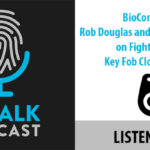FindBiometrics President Peter O’Neill recently spoke with Michael Saylor, CEO of MicroStrategy. ![]() The conversation begins with how MicroStrategy is delivering on its vision of the Intelligent Enterprise. The concept shows us how a unified mobile identity, device management and communication capabilities can be tightly integrated with analytics to bring a simple solution that’s secure and drives unique insights for companies. The interview then highlights how MicroStrategy is solving the most complicated challenges that large telecommunications companies face with IoT applications, a major theme at this week’s 2018 Mobile World Congress conference in Barcelona. The interview concludes with a discussion on how MicroStrategy is positioned to continue to innovate across industries.
The conversation begins with how MicroStrategy is delivering on its vision of the Intelligent Enterprise. The concept shows us how a unified mobile identity, device management and communication capabilities can be tightly integrated with analytics to bring a simple solution that’s secure and drives unique insights for companies. The interview then highlights how MicroStrategy is solving the most complicated challenges that large telecommunications companies face with IoT applications, a major theme at this week’s 2018 Mobile World Congress conference in Barcelona. The interview concludes with a discussion on how MicroStrategy is positioned to continue to innovate across industries.
Read our full interview with Michael Saylor, CEO, MicroStrategy:
Peter O’Neill, President, FindBiometrics: There are few, if any, companies that have delivered a platform that combines identity, mobility, and analytics designed as an enterprise asset. Can you explain why this combination in a single platform is important to your partners and customers?
Michael Saylor, CEO, MicroStrategy: MicroStrategy got its start by delivering a full-featured analytics platform for the enterprise. Then, a handful of years ago, we were early to realize the importance of delivering mobile intelligence to the very edges of enterprises, to our customers and to their customers. This is why analysts routinely identify MicroStrategy as a leader in mobile analytics, including OEM and customized applications. We embed our analytics tools and functions into mobile applications, which are supported by our comprehensive prebuilt gateways, so our enterprise customers have a simplified development process and a streamlined, even frictionless, end user experience. MicroStrategy also recognized that a critical element, using personal identity telemetry and analytics to deliver effective business and consumer insight, had been overlooked in the industry. So, we built Usher, our highly capable unified identity engine into the platform.
Each of these technologies is critical for the enterprise. But, when they converge, the insights that become available are unique. Applications built on the MicroStrategy 10 platform that leverage Usher can be personalized based on the user’s digital identity, role, and the context of any given transaction. This personalized experience goes beyond what a user might see or manipulate in an application. The personal experience also includes the entire process that may require an application to interact with multiple third-party systems or resources with different access and interface requirements, while simultaneously writing back to these systems and resources as the part of the transactions they encounter. For example, Usherized applications consider the proximity of others and physical IoT devices as part of the transaction, and provide recommendations on next steps. In this way, our customers’ applications are adaptive and proactive while ensuring the identity and enforcing the privileges of the user for logical, physical, and IoT access transactions.
The impact of analytics across operational, identity, and access data cannot be overstated. With the addition of Usher real-time identity telemetry and transaction metrics, organizations can both accommodate new and expanded use cases, and discover insights into both customer or employee behaviors like never before. We have customers that have completely redesigned their office and retail spaces, rewritten their HR and customer policies, changed the way people are trained, significantly revamped their mobile consumer applications, and more – all driven by the insight gained from the intersection of their operational analytics with Usher’s identity capabilities and analytics.
With a unified identity wallet and management engine tightly integrated to our mobile and analytics capabilities, users enjoy a more integrated, seamless and interactive experience. All of this is included in our holistic map for the Intelligent Enterprise, a playbook that offers a collection of technologies and techniques to help organizations leverage existing investments and navigate toward becoming a successful data-driven organization.
Peter O’Neill, President, FindBiometrics: I’m glad you mentioned IoT since the IoT market is now exploding. In fact, this year’s Mobile World Congress conference, where I know MicroStrategy will be exhibiting and presenting, has identified IoT as the 4th Industrial Revolution. Can you talk more about how MicroStrategy is addressing the current challenges around identity in IoT deployments?
Michael Saylor, CEO, MicroStrategy: During Gartner’s recent Identity and Access Management (IAM) conference in Las Vegas, Gartner identified two key areas in IoT that come up short: person-to-device mutual authentication integrated into the workflow; and enabling device-to-device capabilities, instead of always going through the cloud to communicate. MicroStrategy already has a capable approach to both.
Usher is a unified credential so that a person’s digital identity can interact with workflow components that rely on logical connections as well as physical interactions. This is critical for IoT because our customers and partners must frequently correlate multiple processes: the person’s verified identity, the person’s physical presence in proximity to the IoT device, and the commands or data being sent to or received from the IoT device via logical channels, either directly or through the cloud. But the Internet, and therefore the IoT cloud, isn’t always accessible. That’s why Usher leverages static or dynamic QR codes, NFC, Bluetooth, and local WiFi to provide mutual authentication simultaneously with commands and data access using multiple methods and pathways. This allows the person’s digital identity to reside on his or her smartphone or smartwatch, or be instantiated using a tightly linked wearable NFC, Bluetooth bracelet, or key fob in case the smartphone is not available or allowed.
Usher also supports an open architecture approach to enabling personal identity to interact with IoT devices. For example, we do not require proprietary hardware to accomplish secure communications using such protocols as NFC and Bluetooth. This is true for the mobile device where the personal digital identity is represented, as well as enabling Usher identity awareness in the IoT device the person is interacting with. We provide our customers with the ultimate flexibility to leverage open architecture IoT device platforms across a broad range of cost and capability.
MicroStrategy has pursued multiple partner initiatives, including working closely with Microsoft to interact with devices and their telemetry managed in Azure IoT Hub. MicroStrategy is also engaged in various IoT projects including Smart City projects in the Middle East and Europe, and connected vehicle projects in Asia and Europe for major auto manufacturers. Telecommunications companies and mobile carriers have especially accepted Usher as an enterprise and customer identity management asset, and have expanded their analytics applications to include Usher – opening our platform to new identity-centric applications.
Peter O’Neill, President, FindBiometrics: With mutual authentication and direct device-to-device communications to trigger actions and interact with IoT devices, you really are opening up new possibilities and levels of redundancy. What is MicroStrategy doing to stay ahead of the curve and to keep delivering such differentiators?
Michael Saylor, CEO, MicroStrategy: MicroStrategy believes in investing in research and development, and growing our offerings organically. This has served us well in frequently beating competitors to the market and influencing the direction of key industry segments. We are committed to product and process excellence and we strengthen our flagship platform, MicroStrategy 10, with quarterly releases that showcase new powerful capabilities. In addition to agile development, we hold datathons and offer continuous education, 80/20 personal project timesharing, and a patent incentive program to our technologists to keep them engaged and leaning forward.
Frequently, our level of engagement with our business partners and customers includes an on-site MicroStrategy center of excellence, staffed with either MicroStrategy employees or our customers’ employees who have been certified by the MicroStrategy Education program. This enables more effective collaboration in developing applications and solutions for their internal enterprise and for their customers.
(Originally posted on Mobile ID World)






![Money20/20: IDEMIA’s Matt Thompson on Making Mobile Digital ID a Reality [Audio Interview]](https://idtechwire.com/wp-content/uploads/M2020-2019-IDEMIA-1-1-e1572391731602-150x150.jpg)

Follow Us